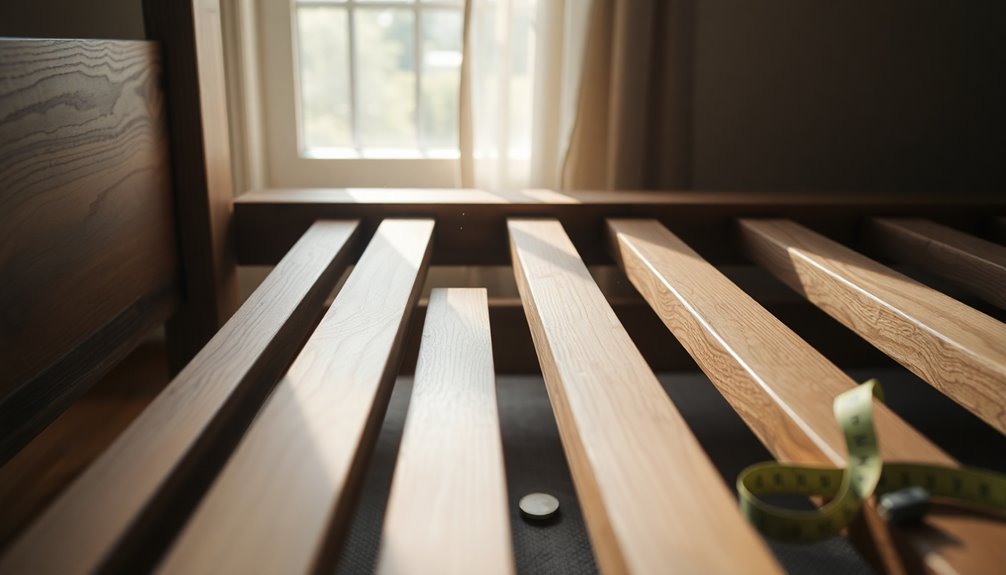Bed slats have gaps mainly to improve airflow and control moisture, which can save you money in the long run. This design helps prevent mold and mildew, extending the life of your mattress. Affordable materials can be used because the gaps allow for a lighter construction, reducing costs. Proper spacing also guarantees comfort by allowing your mattress to breathe, which minimizes disturbances during sleep. Overall, these gaps promote both hygiene and better sleep quality. If you're curious about how slat configuration and material choices impact your experience, there's plenty more to explore that can enhance your sleeping setup.
Purpose of Gaps in Slats
Gaps in bed slats serve several important purposes that can greatly enhance your sleeping experience.
First and foremost, these gaps facilitate air circulation, which helps reduce moisture buildup beneath your mattress. This is especially beneficial in humid climates, as it prevents mold and mildew growth, keeping your sleeping environment healthier. Additionally, promoting sustainable practices in the choice of bedding materials can further enhance your sleep environment. Utilizing budgeting tools can also help you allocate funds for high-quality bedding options.
Moreover, the presence of gaps supports the natural expansion and contraction of your bedding materials. This maintenance of mattress integrity is essential for prolonging its lifespan.
Proper spacing between slats also plays a significant role in weight distribution and suspension, enhancing overall comfort. You'll find that a solid surface mimicking sleeping on the floor can be quite uncomfortable.
When it comes to mattress firmness, the size of the gaps should be tailored accordingly. Firmer mattresses generally require wider gaps to provide adequate support without sacrificing comfort.
Finally, these gaps enhance ease of cleaning under the bed, contributing to better hygiene and the visual appeal of your bed frame. Additionally, maintaining accurate financial records can help you budget for quality bedding materials that support your sleep.
Economic Benefits of Slat Design
Maximizing the design of bed slats not only enhances comfort but also offers significant economic advantages. The gaps in slats allow for lighter materials, reducing the overall weight of the bed frame. This means manufacturers can opt for less expensive wood types, cutting down on production costs. By utilizing less wood, companies can lower manufacturing costs, which translates into savings for you as a consumer.
Additionally, the design with gaps facilitates air circulation, helping to prevent moisture buildup and mold growth. This can extend the lifespan of both your mattress and bed frame, ultimately saving you money on replacements and maintenance. Furthermore, investing in a bed with a well-structured design can lead to improved financial outcomes as it reduces the need for frequent replacements. Studies show that budget management tools can help consumers effectively manage expenses related to home furnishings.
You'll also find that the presence of gaps allows for easier cleaning underneath the bed, reducing the need for professional cleaning services and lowering your long-term maintenance costs.
Manufacturers can optimize slat spacing to create a balance between support and material efficiency. This smart design choice leads to more economical production without compromising the performance of your bed. Moreover, budget apps can help you track your spending on home essentials, ensuring that you make informed financial decisions when investing in quality furniture.
In the end, investing in beds with well-designed slats not only enhances comfort but also secures your financial investment for years to come.
Airflow and Mattress Longevity
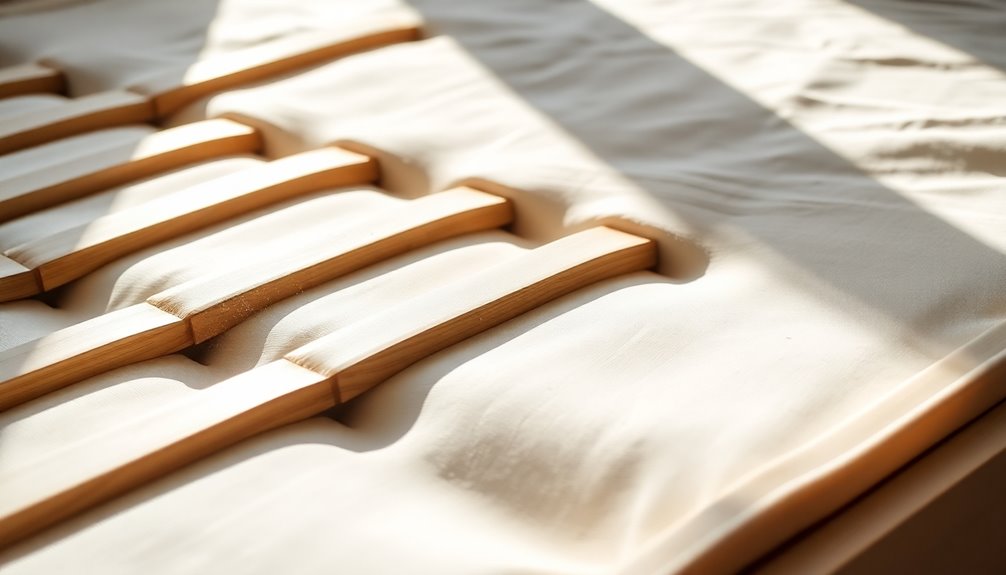
When it comes to bed slats, their design not only saves money but also plays a key role in maintaining airflow, which is essential for your mattress's longevity. The gaps between the slats facilitate air circulation, reducing moisture buildup that can lead to mold and mildew, especially in humid climates. By utilizing efficient bill tracking methods, you can manage your finances better, allowing for investments in quality bedding. Additionally, AI-driven recommendations can help you find the best bedding options tailored to your specific needs.
By allowing air to flow freely, you help create a healthier sleeping environment. Properly spaced slats also accommodate the natural expansion and contraction of your mattress materials. This flexibility contributes to the longevity and integrity of your mattress over time. Additionally, the gaps enhance ease of cleaning under the bed, further minimizing dust accumulation and keeping your sleep space fresh. It's important to take into account the size of these gaps in relation to your mattress's firmness.
Firmer mattresses typically require wider gaps to provide adequate support without sacrificing comfort. Moreover, using slats with gaps prevents that dreaded "hammock-like" effect, ensuring your mattress retains its designed support and enhances your overall sleep quality. Prioritizing airflow through slat design ultimately leads to a longer-lasting, healthier mattress. Furthermore, incorporating AI-driven tools into your shopping can help you find the best options for slats that maximize both support and airflow efficiently.
Slat Configuration for Support
To provide ideal support for your mattress, the configuration of bed slats is fundamental. You need to take into account the gaps between slats carefully. These gaps aren't just for aesthetics; they play a vital role in airflow, which helps prevent moisture buildup and mold growth.
However, make certain the spacing between slats doesn't exceed 2.5 inches. This spacing guarantees adequate support for most mattress types and keeps you in line with warranty requirements.
For pocket spring mattresses, it's especially important to have closer slat spacing. This configuration supports the springs effectively and helps prevent sagging over time. Properly configured slats offer the right amount of suspension, enhancing comfort by allowing your mattress materials to expand and contract naturally.
When adding slats, verify they're strong enough to support the mattress load without excessive flexing. A well-thought-out slat configuration not only supports your mattress but also contributes to a better sleep experience. Additionally, ensuring regular reviews of savings and investments can help you invest in higher-quality sleep solutions that enhance your overall well-being.
Historical Evolution of Bed Slats
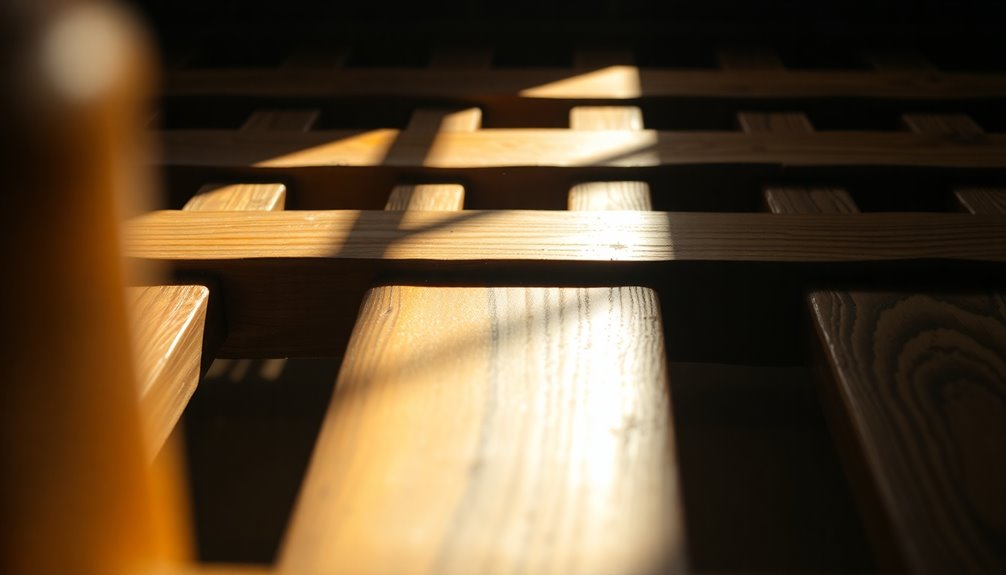
Historically, bed slats have frequently evolved to meet the changing needs of sleepers. In colonial times, beds often relied on ropes or woven materials for mattress support, emphasizing flexibility and air circulation. These early designs featured slats that were spaced apart, allowing for ventilation that helped reduce moisture buildup, especially in humid environments.
As time progressed, the shift to wooden slats marked a significant change towards more durable and stable sleeping surfaces. By the 19th century, slatted bed designs became standardized, with manufacturers recognizing the necessity of gaps for structural support and airflow. This influenced mass production techniques, shaping modern bed frames.
The evolution of bed slats also mirrored shifts in mattress materials and consumer preferences. As mattresses diversified, so did the design of slats, incorporating various thicknesses and spacing to accommodate different types for ideal mattress support.
Today, you benefit from these historical advancements, enjoying a comfortable and well-supported sleep environment. Understanding this evolution helps you appreciate how bed slats have been crafted to enhance your sleeping experience while addressing practical needs.
Health and Maintenance Considerations
When you consider bed slats, the gaps play a crucial role in air circulation, which helps keep your mattress dry and free from mold.
In humid conditions, these openings allow moisture to escape, promoting a healthier sleep environment.
Plus, the right spacing not only supports your mattress but also makes cleaning easier, enhancing overall hygiene.
Air Circulation Benefits
Gaps in bed slats play a vital role in enhancing air circulation, which is essential for maintaining a healthy sleeping environment. When you have adequate gaps, it allows air to flow around your mattress, reducing moisture buildup and preventing the growth of mold and mildew. This is especially important in moist climates, where stagnant air can lead to health issues.
Moreover, proper spacing between slats facilitates the natural expansion and contraction of materials, helping to maintain your mattress's integrity and longevity. The air movement created by these gaps can reduce condensation, which can enhance your mattress's lifespan and overall comfort.
Additionally, the design of bed slats makes cleaning underneath the bed easier, preventing dust accumulation and promoting better hygiene.
It's also vital to take into account that the size of the gaps should be optimized based on your mattress firmness; firmer mattresses require wider gaps to provide adequate support and breathability.
Moisture Prevention Strategies
Maintaining a dry and healthy sleeping environment is fundamental for your overall well-being, and implementing effective moisture prevention strategies can make a significant difference.
The gaps in bed slats play an essential role in facilitating air circulation, which helps prevent moisture buildup and reduces the risk of mold and mildew, especially in humid climates.
Proper spacing between slats allows for the natural expansion and contraction of materials, which is critical for maintaining your mattress's integrity. This helps avoid moisture issues while providing adequate support.
Regular cleaning under your bed enhances air circulation, further mitigating condensation.
When it comes to optimizing the size of the gaps, remember that firmer mattresses require wider spaces to guarantee proper ventilation and support.
If you want to enhance your moisture prevention strategies, consider incorporating materials like blue rigid foam insulation between the slats. This not only aids in weight distribution but also maintains airflow, creating a balanced environment to keep moisture at bay.
Material Choices and Their Impact
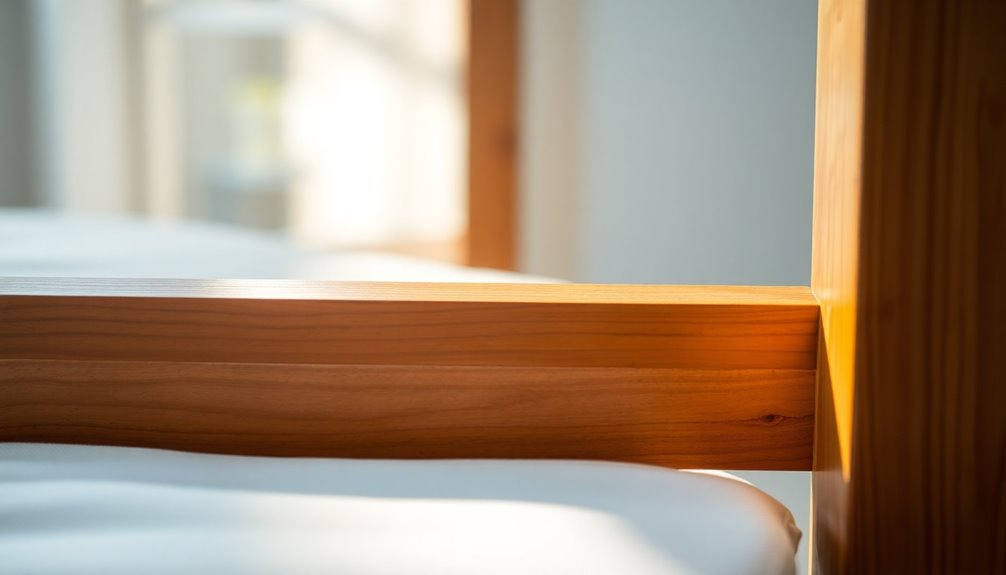
Choosing the right materials for bed slats can greatly affect your sleep quality. When you consider gaps in bed slats, the materials you choose play an important role in supporting the firmness of the mattress. Hardwoods, for example, offer superior durability compared to softwoods. This durability is necessary for maintaining the required gap spacing, which is essential for ideal weight distribution across your mattress.
If you have a firmer mattress, wider gaps can enhance comfort by allowing better air circulation and preventing moisture buildup. However, if the gaps are too large, they may compromise support, leading to discomfort.
On the other hand, a solid surface without gaps could feel like sleeping on the floor, providing inadequate support and potentially affecting your sleep quality negatively.
Properly spaced gaps in slats not only improve weight distribution but also extend the lifespan of your mattress. By choosing high-quality materials, you guarantee that your bed slats can endure regular use while maintaining the right balance between support and airflow.
This careful consideration of material choices will ultimately enhance your overall sleeping experience.
User Safety and Experience
When it comes to creating a safe and comfortable sleeping environment, the design of bed slats plays a notable role. Gaps in bed slats aren't just for aesthetics; they're essential for user safety and experience. These gaps facilitate air circulation, helping to prevent moisture buildup and mold, particularly in humid climates. This is critical for maintaining a healthy sleep space.
The proper spacing between slats distributes weight evenly across your mattress, enhancing comfort and markedly reducing the risk of sagging in the middle. A mattress that sags can lead to poor sleeping posture and discomfort, so those gaps are crucial for long-term support.
Additionally, adequate gaps can prevent entrapment hazards, particularly for children, making your sleeping environment safer. The design also allows for the natural expansion and contraction of materials, preserving the structural integrity of your bed over time.
Ultimately, the balance of functionality and visual appeal in a bed frame can greatly enhance user satisfaction, creating a space where you can sleep soundly without worry.
DIY Solutions for Slat Gaps
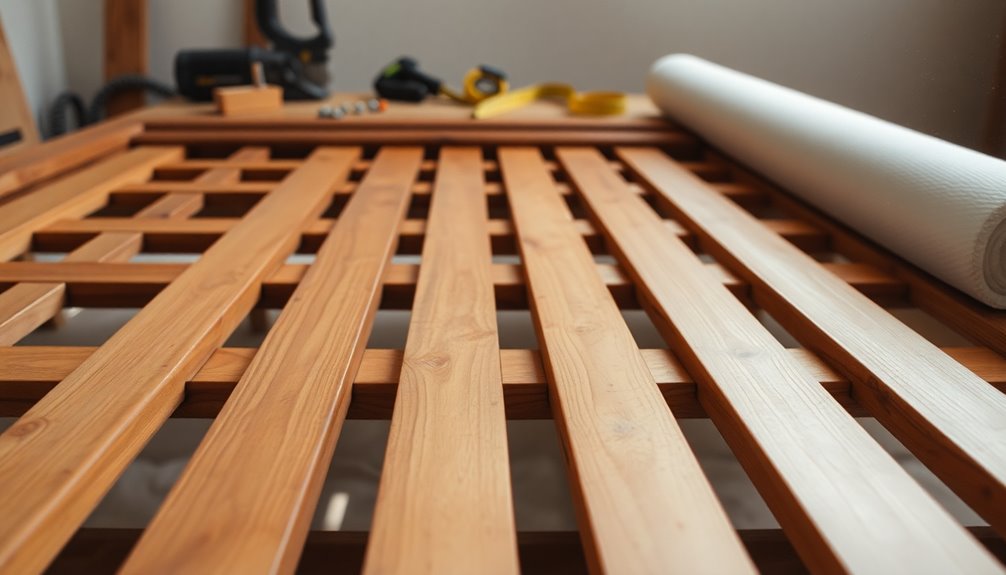
When you're tackling slat gaps, remember that some space is beneficial for air circulation, helping to prevent moisture buildup.
However, if the gaps are too wide, you can easily customize solutions to enhance support.
Consider adding more slats or using plywood sheets to create a solid base that keeps your mattress comfortable and secure.
Air Circulation Benefits
Maintaining ideal air circulation in your bed is essential, especially in humid climates where moisture buildup can lead to mold and mildew. The gaps between bed slats play an important role in promoting this air circulation, ensuring your mattresses stay fresh and hygienic.
These spaces allow air to flow freely, reducing the risk of moisture accumulation and the growth of unwanted contaminants. Additionally, the proper spacing of slats supports your mattress's natural expansion and contraction, enhancing its integrity and longevity.
When you choose to incorporate gaps, you not only improve airflow but also make cleaning under the bed easier, contributing to overall hygiene. If you have a firmer mattress, consider wider gaps to provide ideal support while maintaining air circulation.
You can also implement DIY solutions, like placing rigid foam insulation between slats. This method helps distribute weight evenly across the bed frame while still allowing for the necessary gaps.
Custom Gap Solutions
Custom gap solutions can greatly enhance your bed's comfort and support. If you're looking to optimize your setup, consider these DIY options to address those pesky slat gaps:
- Rigid Foam Insulation: Place rigid foam insulation between your wood slats. This distributes weight evenly and minimizes sagging, making it ideal for your memory foam mattress.
- Plywood Sheets: Cut plywood sheets to size and lay them across the slats. This creates a solid surface, offering an alternative to box springs while maintaining structural integrity.
- Extra Slats: Incorporate additional wood slats spaced no more than 2.5 inches apart. This boosts support for heavier mattresses and enhances overall stability.
- Repurposed Lumber: Use scrap wood from home improvement stores or leftover lumber to craft additional slats. This allows for custom gap solutions tailored to your specific mattress dimensions.
Conclusion
To sum up, gaps in bed slats aren't just a design quirk; they serve practical purposes that can enhance your sleep experience. Did you know that over 30% of mattress warranties are voided due to improper support? By understanding the benefits of slats, you can make informed choices that boost your mattress's longevity and your comfort. So next time you notice those gaps, remember they're there for a reason—your sleep quality can depend on it!

